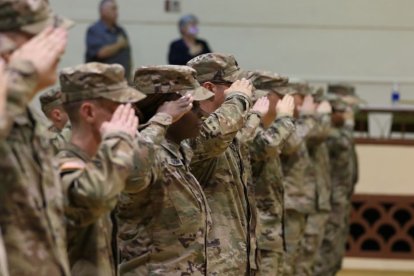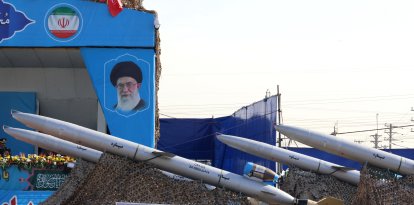The persistent decline of the U.S. military
Diagnostic errors, ignorance, disinterest, lack of motivation and aptitude, along with the progressive failure of promotional, marketing and incentive strategies have been detrimental for the training of the Armed Forces of the world's most powerful country.

(Cordon Press)
The U.S. military is facing a recurring crisis: the dwindling number of Americans willing and able to serve in its ranks. The Pentagon must strengthen strategies for recruiting and retaining troops if it wants to fight future wars with a competitive force. For several years, military recruitment problems have endangered national security and, taking into account current trends, future prospects are worrying. It is possible that part of the situation can be alleviated with investments in unmanned weapons systems, higher precision munitions and other gadgets that allow the military to reduce manpower needs, but that alone will not reverse the problem.
The crisis only seems to be worsening. Combating threats on a global scale requires a high-level military, a much more important objective than compliance with DEI standards and other progressive interventions that have been condemned both in the media and different political spheres. To fill the deepening gap, the Army is offering incentives to attract new recruits, such as relaxing physical fitness standards and making it easier for recruits to get waivers for prior drug use. Financial bonuses, faster promotion opportunities and expanding the pool of potential enlistees by placing more recruiters in communities with low levels of military involvement are just some of the strategies being implemented to reverse the trend.
Other kinds of incentives have also been incorporated, including more medals, early recognition and promotions, as well as simplifying the naturalization process so that recruits can become citizens during basic military training. There are also bonuses for previously served airmen, a college loan repayment program for enlisted personnel, the allowance of hand and neck tattoos, and even permitting those who test positive for THC (the psychoactive component of marijuana) to retest under a new pilot program. Even with all this nothing delivered the desired results.
The truth is that the U.S. Armed Forces have not managed to recruit the more than 40,000 soldiers that were the goal for 2023. The Pentagon's assistant secretary for personnel and readiness said the figure "understates the challenge before us as the services lowered [their] end-strength goals in recent years, in part because of the difficult recruiting environment." With 2023 recruiting goals missed and the National Defense Authorization Act (NDAA) reducing its force to 1,284,500, the military will reach its lowest levels since before the country entered World War II, and some officials are concerned the difficulties will continue into 2024.
Of the Defense Department's five service branches, only two met their goals: the Marine Corps and the Space Force.
Against this backdrop, authorities maintain that the purely voluntary force faces one of its greatest challenges since the beginning of the 1970s, because young generations have little trust in institutions and are increasingly less inclined to follow traditional life and career paths. The drop in interest and participation levels has led to a relaxation of demands, which does not seem to be an optimal path, as it could send a dangerous message to powerful adversaries such as China and Russia.
The military has tried to reach young Americans in several ways, including eliminating basic educational requirements and lowering other physical and mental fitness standards. Due to alarming obesity and addiction rates, the proportion of Americans aged 17 to 24 who are eligible to serve without a waiver, has fallen to historic lows. The military estimates that of those who are eligible, just 9% have a "propensity" to serve, the lowest since 2007, during the Iraq war.
The Marine Corps was the only service to meet its 2023 recruiting goals in all categories. However, despite an avalanche of bonuses, relaxed enlistment requirements and even the creation of programs to entice recruits into boot camps, the Army failed to get more Americans to join its forces. Of the five service branches of the Department of Defense, only two met their objectives: the Marine Corps and the Space Force. The others, the Army, the Air Force and the Navy, fell short. The trend seems to be similar in many Western countries. For example, Canada's military currently has much more serious shortages, and a significant number of its military positions are vacant.
The problem is long-standing. When Army leaders projected late last year that the number of active troops by 2023 would be short by nearly 20,000 of the projected 485,000, this quickly led the force to take a new course of action, leading to an important debate in the public discourse. Hundreds of millions of dollars were spent on marketing programs, but the results were even more dismal. The service spent millions on high-profile ads during events like the Super Bowl and was generous in granting exceptions "to consider people who may have been previously disqualified." The Navy even raised the maximum enlistment age to 41 and relaxed entrance exam rules.
The problem will most likely continue as the military shrinks and familiarity with the service becomes unusual and distant.
For the Department of Defense, it is clear that Generation Z, which includes those born between 1997 and 2012, is the key to the future of the military, but it has failed to connect with the interests and motivations of this base. The U.S. military has been an all-volunteer force for half a century, eliminating mandatory conscription and drafts for service. The Pentagon has published studies showing that only 23% of young Americans are eligible to serve due to epidemics of obesity, addiction and mental illness. Of that 23%, it is possible that many do not feel encouraged to enlist due to changes in social paradigms, meaning that they do not have the same motivations as their parents' or grandparents' generations.
For example, only 13% of entering-age Americans have a parent who served in the military, down from 40% in 1995. In 2018, 74% of American adults had a lot of trust in the military, but by 2022, that trust had dropped to 64%. Among those between 16 and 21 years old, the proportion with a very favorable opinion of the military fell from 46% in 2018 to 35% in 2022. Overall trust in U.S. government institutions is also declining, and that clearly affects the military. In 2021, the Annual National Defense Survey conducted by the Ronald Reagan Presidential Institute found that only 45% of Americans had great confidence in the military, down 25 points from 2018.
Many analysts also blame the GENESIS program, an automated and integrated medical information system that helps manage more comprehensive medical examinations and increase efficiency, but which has caused significant delays in processing applicants. Once an applicant signs their consent, GENESIS processes their entire medical history, flagging past and present health issues. Recruiters say the most common delays include ADHD medications, antidepressants and counseling. Mental health is a recurring reason why applicants requested medical exemptions, according to data provided by the Department of Defense. Diagnoses of mental health problems are higher for Generation Z than for previous generations. In this sense, the American Psychological Association reported in 2019 that Generation Z and millennials are more likely to rate their mental health as fair or poor, and that more people say they receive treatment or therapy, compared to baby boomers, and this problem was amplified by the isolation measures implemented during the COVID-19 pandemic.
The problem will most likely continue as the military shrinks and familiarity with the service becomes unusual and distant. In 2021, an Army study found that 75% of Americans aged 16-28 knew little or nothing about their military. Diagnostic errors, ignorance, disinterest, lack of motivation and aptitude, along with the progressive failure of promotional, marketing and incentive strategies have been detrimental for the training of the Armed Forces of the world's most powerful country. History is prolific in examples of how empires fall, and every decline is preceded by the degradation of their military.
RECOMMENDATION





















